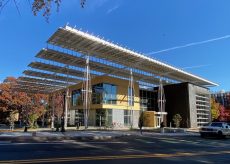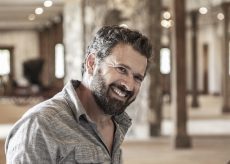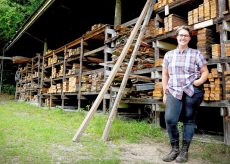Mustard Seed leads the way for the Tiny Home movement
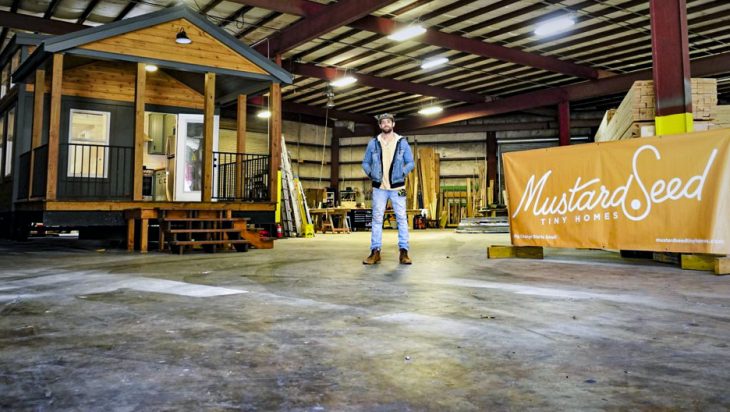
Every day, more information about the tiny home movement hits the mainstream–from HGTV’s Tiny House Living, to resource sites like Tiny House Build and Tiny House Life, commercial builders like Tumbleweed Tiny Houses. Not to mention the constantly growing number of blogs and podcasts, including Tiny House Lifestyle.
As tiny homes have grown more mainstream there has been a steady increase in people giving up their conventional homes for tiny living. There are many reasons, some include the mobility, vastly lowered costs of living, and improved carbon footprint. Ironically, however, the information available on this movement of decluttering and living more simply has, itself, become cluttered, complicated, and often, contradictory – and none more so than the legality of it all.
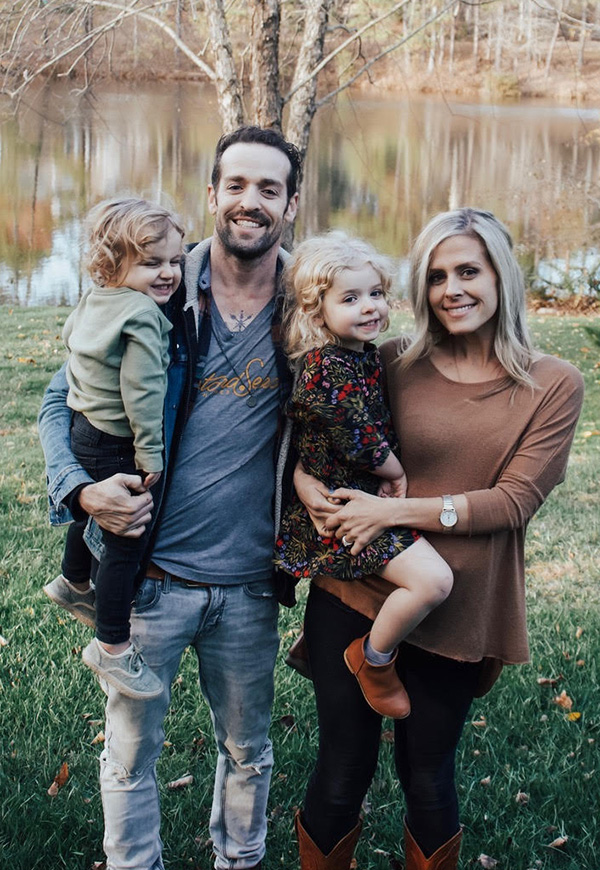
The Net Positive decided to go back to Clint Gooch, founder of Mustard Seed Tiny Homes, to dive deeper into his story, his brand, and how he’s balancing his dreams of cultivating community with his growing family.
[Add’l Comment: Clint’s wife was extremely pregnant with their third child during this interview and could have gone into labor at any moment. There were several instances that she called, and when Clint would answer, very excitedly, you could hear her saying “it’s not coming, don’t worry, I just wanted to ask about…” and both would laugh, as well would myself and my fiancé/photographer.]
the Net Positive: Clint, I know that in your last interview with tNP, you mentioned that your main goal is encouraging more community interaction in the tiny home movement. Where are these tiny homes going? Aren’t there strict city codes and zoning regulations against living in tiny homes? Can you elaborate on those?
Clint Gooch: Well, you’ll see in Suwanee, they’ve got a lot of multi-family condos coming up, but the city – and especially in the Old Suwanee area – wants to do smaller homes and not have as many people coming in, while still maintaining that quaintness of the Old Suwanee area. We’ve been talking to them for a while. There’s honestly several of these little pockets of land in Old Suwanee that we’d love to do a development with, and the city has said, ‘Just show us… Give us some ideas.’ So, they’re open to it.
We’re actually building a tiny house for someone we know, and my mentor, who I’ve been working with since I came back from doing missions, is building her house. We designed this little accessory dwelling unit for her mom, and the city (Suwanee) passed it in a day.
tNP: So, more than anything, it depends on the municipality?
CG: For the most part. You have to find a place with no minimum square footage laws for homes.”
Minimum square footage laws require a certain amount of space per family and within dwellings. Originally, these laws were created to control population densities and help control urban sprawl. Unfortunately, they have had the inverse effect of creating red tape for innovative initiatives like tiny homes.
“It can get a little complicated – a little muddy – but it’s just all about what you call it. You know, I’ve been doing this almost four years now, and we’re still just trying to find what people are okay with. But at least there is a route.
tNP: And this park model you mentioned in the last interview, it classifies your tiny homes as an RV?
CG: Right, the RVIA certification – the RV Industry Association – but then you have to think about the kind of spots that can have RVs. You can’t just park it on your own property. It has to be zoned as an RV park.
When we started doing tiny homes, we were doing the 8-1/2 ft bys that you see on TV. But when I found out about the Park Models, I reached out to this company about just giving me whatever I needed to get their (RVIA) certification and their financing. They ended up basically just sending the shell – no interior, no HVAC, no lighting, siding or trim – and then I realized how low quality the build – and the materials – were, and how high of a price they were charging me. All that came in the interior was the rough loft, the plumbing, and stairs, but then we even ripped out the stairs and put in our own.
These crews are just big contractors – They’re used to full sized homes and don’t think about the little things, like their nail holes. They just pop ‘em out and forget about it. But when you’re in this little of a space, the little things make a big difference.
“…when you’re in this little of a space, the little things make a big difference.”
I realized I can do the same thing, but for way cheaper, and not have to fix all the little details they overlook.
tNP: This park model you have here, it’s way bigger than I expected. What’s the square footage of one of these?
CG:Yeah, it’s a lot bigger. This is the Jackson. This one’s got two bedrooms on the main floor, one and a half bath, and it’s got a huge loft.
Traditional tiny homes are under 400 sq ft – that’s what I’ve always heard. And these RVIA park models are 13’ 8” wide, and then made a certain length where the first floor is less than 400 sq ft. They don’t count the loft space, and they don’t count the front porch. It’s just the square foot of the main floor. It’s the same for tiny homes and RVs.
But that’s why what we’re doing now is called modular homes. With modular, we can make it any size we want.
tNP: And then it can be placed full time?
CG: Once it’s placed, it’s basically full time. Hauling these things… It costs a lot. These guys haul it, they place it. They level it… and it’s all included in your financing. And this is a product that you can get good financing for. But I mean, it’s (the customers) money. They can move it if they want.
tNP: So what else is included in this process?
CG: Well… Once you find a place without the minimum square footage laws for homes, we go through the P&D process… the planning and design… find out what you want, and we take those plans and get them engineered stamped. Once they’re engineered stamped, which comes with a foundation plan for what you’d need to place it, we have a third party inspector that inspects for modular for each state, and after the inspection, you take it all to the city and they’ll release the permit. And then, after it’s placed, they’ll come out and do the final inspection.
tNP: How many do you think you’ve built and sold?
CG: This size (Park Models), only four. Tiny Homes? Probably eight a year for like four years. They kind of come in waves, you know? That’s why I’ve only got one full time guy, David. He does the sales, and he talks to people. I don’t talk to anybody until they’re ready to sign a contract. I make sure he’s not promising things we can’t handle, and then I figure out design and pricing and everything.
But we’re about to move this one out to a Lowe’s, and then were going to have four homes we’re doing for a university in Michigan that came to us like six months ago. They’re developing student housing for families or single mothers… and they’re designing for 11 more.
tNP: You talk about quality a lot. Does that mean you would say you’re on the high-end side?
CG: Absolutely. You’ll see we do these tiny home events, and I love, love that community, but it also kind of makes me feel bad. We bring in these houses we build, and everybody is like, ‘This is so awesome,’ and ‘This is the best house here’, or ‘This is so much nicer than all the other tiny houses.’ And you’re talking to people while the builders of the other houses are right there, and you’re just like, ‘Thanks, man…
We’re definitely getting there, though. Even this house, I mean, we have these events and people pay $20/person to get in these events. They wait 30 minutes in line to get into our houses. It’s crazy. Eight hours a day.
tNP: Where did you learn how to do all this?
CG: It honestly took me years. I’ve been doing carpentry for a long, long time… I mean, since me and my dad and a group of people started going down to Mississippi to help after Katrina. They were hit really hard by Katrina, but no one really gave them anything. It was all New Orleans.. You know what I’m saying? So, over three years, we did like 15 trips, and we were just working with a bunch of rough, rag-tag construction dudes that just wanted to help people out. We would go for like four days or just long weekends and work for as long as we could and then go back like 3 months later. I learned a lot, and I realized that’s what I wanted to do. So, I started going on short-term mission trips, doing construction in other countries for a while…
Then, right after my wife and I got married, we moved to South Africa, and I was teaching carpentry in a local township. And again, I was not building houses yet. I was just building picture frames and tables and stuff.
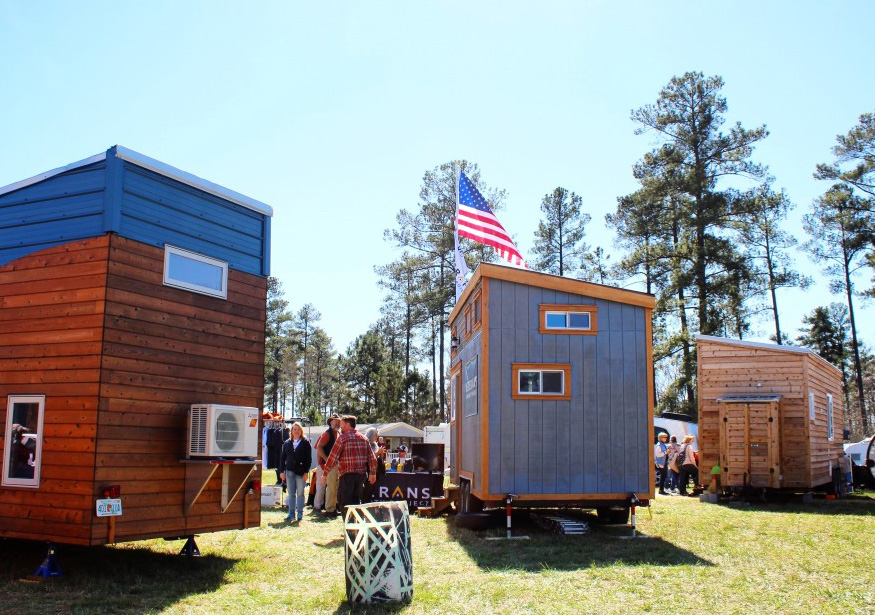
When my wife got pregnant, we moved back to Hawaii, where I had already worked for a few years doing maintenance and helping train new missionaries before they would be sent out all over the world – and I’m telling you, they send out probably 2,000 missionaries a year, so it’s got a lot of maintenance – and I was working under this high end carpenter and just learned a lot from him. I mean, I loved living in Hawaii, but then I felt this call to come back to Georgia and do this business. I was like, ‘Okay, let’s do it.’
So, we moved back here, and while I was working for this company building furniture, we built this tiny house, and this idea started to develop some more. I met with this guy I knew that built big, quality homes, and laid it all out – how with every home we sold, we could give away money to ministries – through missions we knew about that could build houses for families – how when we were in South Africa, we could build a house with, not for, a whole family for like $800 – We wouldn’t just build it and say, ‘Hey, see you later. Jesus loves you. Bye.’ We’d say, ‘You provide the door and the window. We get all this other stuff and we’ll build it with you.
He said, ‘How can I help you?’ And I told him, ‘Introduce me to your vendors and your subcontractors, because when I walk into North Georgia Building Supplies, no one will talk to me. When I call a plumber, they don’t pick up. It’s all good ole’ boys, and I’m just a punk kid covered in tattoos. Nobody takes me seriously.’
And he told me, ‘Okay, I’ll help you out.’ I mean, this guy, he knows everybody. He’s very connected, and he’s all about meeting people and making connections. He’d just always be like, ‘Oh, I should hook you up with this guy. I should hook you up with that guy.’
Then, he introduces me to Jay, this little 5’2” Iranian muscle guy, and I give Jay this scpheal. Jay takes me to his warehouse and says, “Okay, you can use this space.” And when I asked what he wanted to charge, he just said, ‘Nothing. Just get yourself covered with insurance.’ And ever since then, Jay and I have built, like, honestly, this father-son connection.
This guy… He was doing bread production for 20 years before he started with this lumber business. But he’s worked with me for the last three years, and every time I’m about to pull my hair out, I’m like, ‘Jay, help me out.’
I’m telling you, a lot of these guys in later years.. I’ve realized a lot of them just want to pass on what they’ve learned… And so, I feel like I’ve just been surrounded by these good men in different areas… while I’m just trying to learn.
“I feel like I’ve just been surrounded by these good men in different areas… while I’m just trying to learn.”
tNP:What’s next for the Mustard Seeds brand
CG: Like I said, I’m just trying to figure out what works. I’m just a little small fry, you know – make the connections and build relationships. I’ve developed really good relationships with Lowe’s and Home Depot, and I just reached out to Velux for the tiny house I’m building next to my new house. We sent them some info, told them we’d feature them on our social media if they sent us some free stuff, and they sent me two free Velux windows.
And that’s how that works. My wife does all our social media, and we’re really building our new tiny house as an affiliate marketing tool. We don’t want commercials. We don’t look at billboards. We don’t listen to the radio. We get it through our phones. And they say 80% of a business’ marketing revenue goes to social media marketing now.
I’ve also been developing this fundraiser to give away a tiny house by selling raffle tickets – we’re actually trying to plant seeds as the ticket, like $20 for one, three for $50, eight for $100 – and raise money to give to these ministries, including a local nonprofit my dad started, Ground Zero Grace, that helps our families in need, and elderly in the area. But, all the red tape you have to go through to give away a house is crazy. It’s like, you find a lot of people that are doing these raffles and things, and they’re just keeping most of the money.
But we’ve got just about everything developed. We’ve got videography from South Africa – we’ve got storylines – we’re even working on having 15 different influencers in different spheres to make a post, not be the face of it or anything, but just make one post that we’ll send to them when it’s time – and all at different days. This is a crazy idea, but if the math works out, assuming the average person spends $44, and we can get 200 people per state over six weeks, we could raise almost $500,000. People will get a chance to win something really, really cool, but really it’ll be promoting the story – building this story – the brand – and that those good things are happening. And if you wanna be a part of it, you can.
Really, I love what I do. It’s awesome, but I don’t really care about… Like, I’m a missionary at heart. I wanna do stuff for people. I wanna be able to spread this story. That’s what this giveaway is gonna be doing.
So… we’ll see, man. It’s just trying to keep focused and, you know.
Photographer: Cheree Langford

